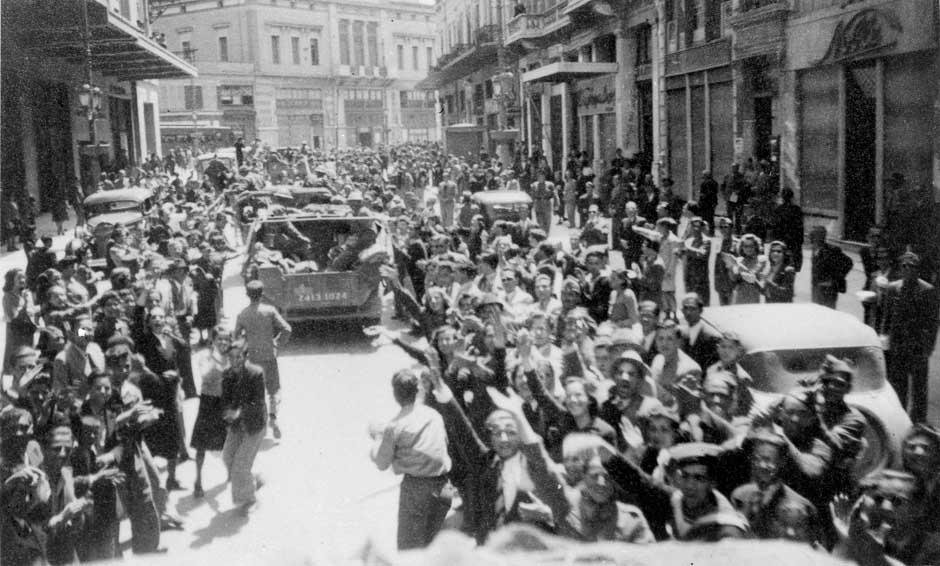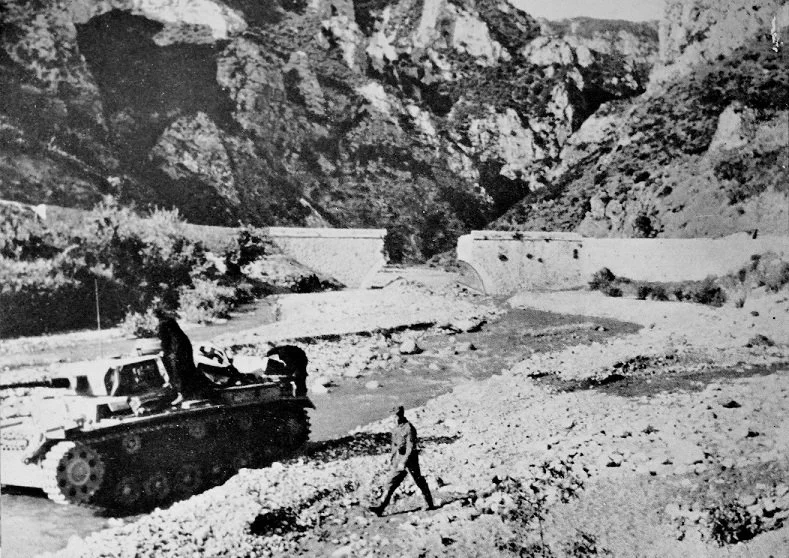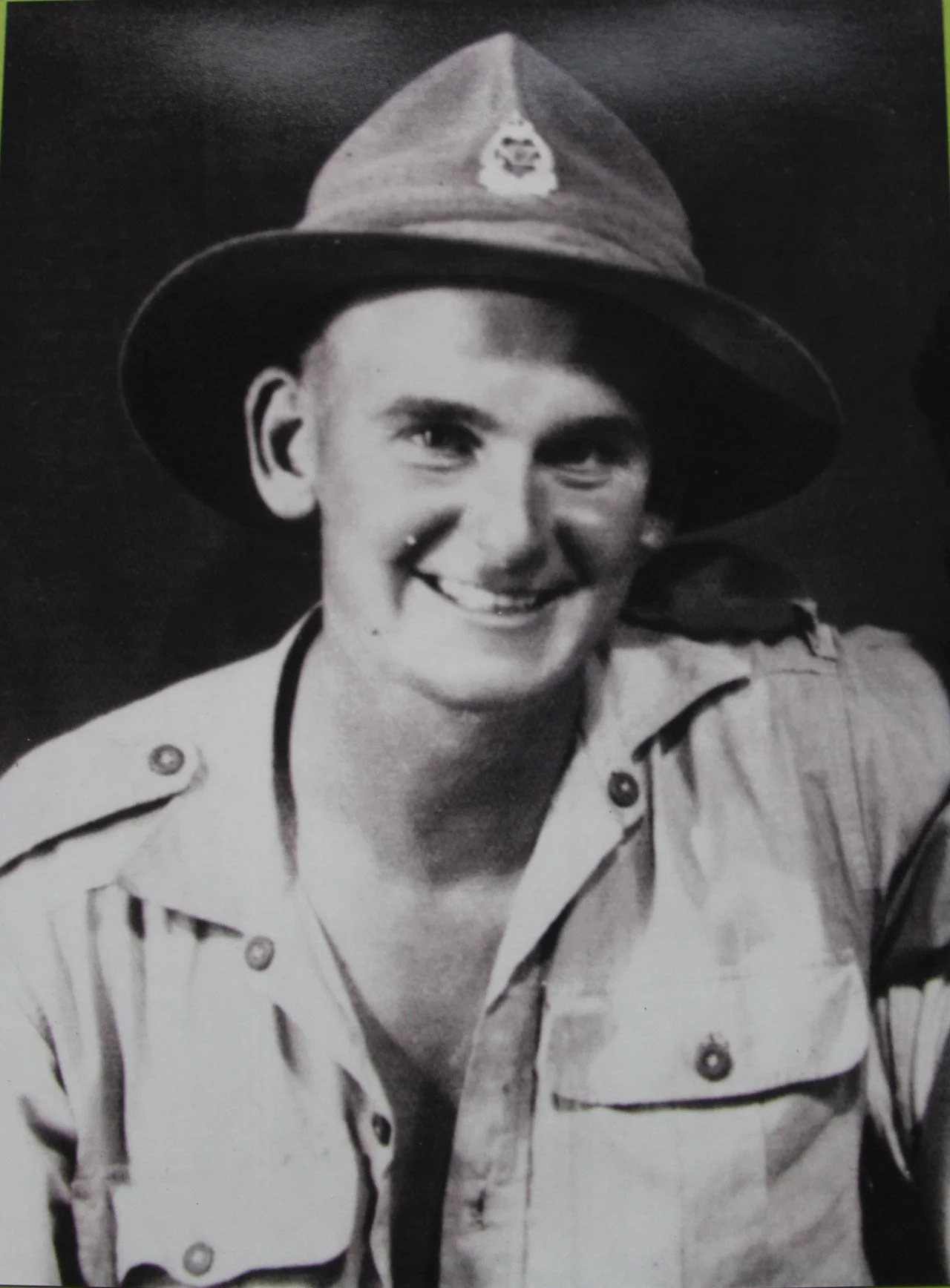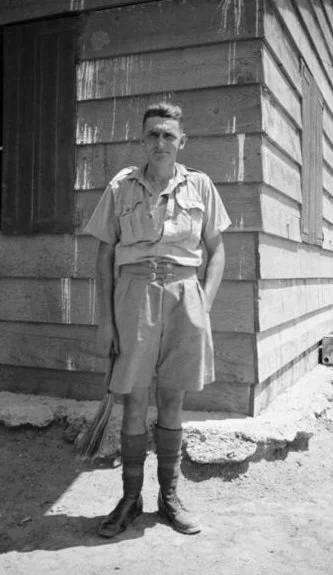
“We cannot abandon the Greeks to their fate especially after the heroic resistance with which they have met the Italian invader. To do so would destroy the moral basis of the cause. Nz troops will be sent to Greece.” New Zealand Prime Minister Peter Fraser
-
2nd NZ Division gets deployed to Greece
In March 1941, the division was deployed to Greece to assist British and Australian forces in defending the country from an expected German invasion.
-
Battle of Thermopylae
General Vasey, commander of the 19th Brigade (Australian) famously instructed his troops: "Here we bloody well are and here we bloody well stay!"
-
Outcome
The campaign was ill-planned and ultimately unsuccessful, with the Allies forced to evacuate Greece in the face of superior German forces.
Most of the 2nd NZ Division was among the troops evacuated by the Royal Navy in the last week of April 1941. In the ill-fated effort to support Greece, the division lost 291 men killed and 1,826 taken prisoner.
New Zealand is wholeheartedly in the fight for liberty alongside the motherland with the other countries of the British Commonwealth and our allies.
Prime Minister Peter Fraser
With no experience yet of battle the New Zealanders had waited for the German army with a mix of of naivety and nervousness. On the afternoon of the 13th of April the Germans approached a destroyed bridge. They were shelled quickly and withdrew. As the German tanks arrived and in the firefight that followed the Germans suffered heavy loses and the river remained uncrossed. New Zealander Eric Davis wrote ‘Hell it was good’ Stood to all morning and watched our artillery blow the hun to bits. Should i survive this I’ll always remember our first day as front line troops.
Aliakmon Line, Greece, 1941
He was a 34 Year old sergeant who had asked to return to combat, sheltered behind a tree and kept shooting so his section could pull back. In the end, the butt of his rifle was blown off and he was seriously wounded and he was left for dead by the advancing Germans.
After the battle he rose like a ghoul in a zombie movie and wandered aimlessly for a week until he sought medical help in a nearby village and was captured.
He was later repatriated by the Germans to New Zealand
He later wrote: “The Germans treated me alright mainly due to my condition. They carried me to a truck and a man in the front seat gave up his place for me and he climbed into the back.”
I dived for the loose ammunition in my pocket. It was slow loading. But every bullet told. No one but a blind man could miss. Fire was point blank. Harry Taituha battle of Mount Olympus 1941, Greece
Corporal Harry Putangaroa Taituha
Bernard Freyberg
When told of the order to catch a flight out of Mainland Greece, Freyberg responded “He was in the midst of the battle of Thermopylae, attacked by tanks, who would command New Zealand troops if he left.”
When asked later why he stayed when the other officers left. He simply said “They went I refused.”
Battle of Thermopylae 1941
On the morning of the 24th dive bombers attacked the largely abandoned positions on the depleted defence line. German infantry advanced causing severe casualties among the Anzac defenders. In the afternoon the first two German tanks advanced crossing a repaired bridge and pushed across the area the Spartans had long ago held back the Persian invasion. The New Zealand artillery stopped them in their tracks. By late afternoon nineteen German tanks had followed, advancing on the defenders. Twelve of the panzers were destroyed by the New Zealand artillery. one Australian solider wrote “The pressure is on again and the tanks have broken through, this may be our last stand but we will have a go, goodbye just in case”. The attacked stalled when night fell. Under cover of darkness the remaining guns were disabled and the defenders withdrew.
Kiwi drivers drove past burning tanks to pick up forward gun crews four lorries went to far and rounded a bend only to find them coming face to face with the enemy tanks. jamming on their breaks, the drivers came under intense machine gun fire and fled into the darkness leaving the Germans with lorries full of canned pears.
Evacuation of Greece
Ken Frater (Left) a Nelson truckie before the war was sent to pick up a New Zealand platoon. As the tired troops emerged from the gloom, the passenger door opened up and a voice said “Stay where you are, the men are getting in the back. My name is Arthur Wesney.” (Right) There was a slap on the cab roof and getting in the passenger seat the man said, Right, get going” Are you the All Black asked Frater
“Yes i am. Now I’d like to get some sleep.” During the evacuation of Greece
The German airborne Operation Hannibal commenced at 06:30 on Sunday, 26 April 1941, when the first Stuka bombers appeared over the Corinth Canal, completely surprising the men of the Commonwealth. As they emerged suddenly from the unusual morning fog, flying silently just 30 m above the sea surface. From that moment, a relentless bombing campaign began, targeting artillery and defensive positions. The British gunners returned fire en masse, firing incessantly, but soon many of their guns were rendered inoperable.
Around 07:10, six gliders landed near both ends of the bridge, disembarking a German Engineering Section aiming to seize it intact and remove the explosives from its metal framework.
A kiwi defender Fred Woollams pictured here, was about to withdraw with his platoon to the other side of the canal when it came under intense sniper fire. “Some lead sprayed in my direction, the former Manawatu shepherd recalls “my feet unfortunately catching a piece. Then there was a yell from Graham, who had got it in the stomach. Two of his mates considered he was beyond human aid so they withdrew as ordered.’ As they did so, anther kiwi was hit in the back. He stumbled up and tried to get away, but the Hun got him again in the same place and position. As the sniper was invisible, we just sprayed the tree with lead. And there was silence.”
The Germans had caught the defenders by surprise and captured the bridge intact. German engineers rushed onto it ripping the fuses out and throwing demolition charges to one side.
At the same time two officers of the New Zealand Engineers J. P. Phillips assisted by observer Lieutenant J. T. Tyson aimed with a rifle from a distance of 150 m at the deactivated explosives stacked in the middle of the deck, managing to detonate them with his second shot. The bridge suddenly blew up and its debris cascaded into the canal, taking with it the German soldiers working on it.
For the defenders it was a hopeless position within an hour the Germans had erected an emergency bridge and captured or killed most of the defenders. those few who got away joined the rest of the commonwealth army in full retreat south.
For Woollams platoon who were now trapped north of the canal they wandered the countryside for several months trying to get of Greece until eventually they were betrayed and handed over to the Italian occupation force.
The battle of Corinth 26th April
Slamat disaster
A convoy of ships left Navplion, Greece at 4.30am with 2,800 evacuated troops. One ship the Slamat was supposed to have left earlier but the Dutch troop ship Slamat delayed her departure possibly under pressure from Australians on board to wait for more of their mates. She finally set sail when a British royal navy officer came alongside in a motor boat and gave a direct order to weigh anchor.
They were not far from the Greek coast when the sun rose and German Stukas arrived. The Slamat was hit twice killing the Dutch skipper. Only a few lifeboats could be lowered from the burning ship as she veered out of control.
The destroyer Diamond was soon on the spot picking up survivors under constant dive bomber attack. Another British destroyer Wryneck came to the assistance also to pick up survivors.
A few hours later a second German air raid arrived. Both destroyers were hit and the decks were racked with machine gun fire across the crowded decks. Diamonds store of torpedos were hit and she blew apart. Wryneck was soon to follow. A bomb landed in the engine room flooding the ship. Both ships sunk within minutes.
After the incident HMS Griffin was sent to look for them. All she was able to find was a life raft drifting on the Mediterranean with around fifty soldiers and sailors from Wryneck. They were the sole survivors of nearly 1,000 people who were killed with the loss of Slamat, Diamond and Wryneck.
Evacuation of Monemvasia
“This is the Royal Navy” If there is any British or Allied troops ashore announce your formation and the name of your commander. Over”
British naval officer during the evacuation of commonwealth troops from Monemvasia, Greece
Freyberg stepped forward and addressed the night in a high pitched voice. “We have approximately 1700 all ranks, principally New Zealand infantry with elements of British and Australians. Major- General Freyberg is in command. I am Freyberg.
During the night all the men were ferried out to the awaiting ships eventually Baillie Grohman said “Come on lets go” and the two senior officers got on the last landing craft out the HMS Ajax. The evacuation was a success but it wasn’t to be repeated at Kalamata.
By the evening of 26th April 15,000 troops had gathered around the fishing town of Kalamata most of them Australians. That night 8,650 men were successfully evacuated leaving 7,000 men behind but by the next evening it turned into 10,000 as people flowed in from different areas. During the next day German aircraft bombed the town causing casualties to fill up the field hospital. Soon the Germans arrived and took most of the town and captured many soldiers. there was no unified response with some troops engaging the Germans and others fled. The British general then ordered the 1000 strong Anzac contingent in the olive fields to retake the town. Jack Hilton a New Zealander then heard that the attack was not happening and yelled “To hell with this! who will come with me?.” He and other New Zealanders then went forward to engage the Germans and eventually all hell broke lose. Men darted from one cover to the next, taking shots as they went.
New Zealander Doug Patterson wrote “We were exchanging fire along the waterfront when a truck without a canopy and full of Kiwis whizzed past me. I saw a one chap, a Maori I think with a tommy gun and one chap with a Bren gun leaning over the hood. The truck rushed the big gun, the chaps firing as they closed in.”
When the truck rushed past Hinton and his group followed in and joined the skirmish. The truck was actually full of Aussies and Kiwis who were stopped 50 meters from an enemy gun. They jumped out and engaged the enemy. The New Zealanders then charged with bayonets and cleared out the Germans. Unlike normal battles many of the men didn’t know each other so the Anzac troops had to constantly yell out Kiwi, Aussie. One New Zealander named Jonah Jones from Invercargill wrote “This is the best night he’d had since he left New Zealand.” During one engagement after a grenade was thrown through a window, 60 Germans came out with there hands up. One spoke good English and said “You’d better look after us because our main party will be here in an hour.” In another part of town the Australians surrounded a temporary headquarters for the Germans. They were then forced to surrender when the Aussies threatened to shoot both of the officers who had came out to negotiate. With that 120 German prisoners were taken. Unfortunately that night only 332 troops were embarked by British destroyers leaving 8,000 left on the beach.
With the rescue ships gone, low on ammunition, no rations or medical supplies the officer in charge surrendered.
Thousands escaped into the hills and a further 300 troops were evacuated at random by British destroyers.
So ended the rescue mission and the battle for Mainland Greece
Chaotic battle of Kalamata
Photo of Doug Patterson
Jack Hinton 1909 - 1997
Jack Hinton was awarded the Victoria Cross (VC) for his actions on the night of 28 April 1941 at Kalamata during the evacuation from Greece.
A column of German troops had entered the port, prompting Hinton – apparently tired of retreating – to organise a counter-attack. The action is described in the citation for his VC:
Yelling ‘to Hell with this, who’ll come with me?’, Hinton:
ran to within several yards of the nearest gun; … he hurled two grenades, which completely wiped out the crew. He then came on with the bayonet followed by a crowd of New Zealanders. German troops abandoned the first 6″ gun and retreated into two houses. Serjeant Hinton smashed the window and then the door of the first house and dealt with the garrison with the bayonet. He repeated the performance in the second house and as a result, until overwhelming German forces arrived, the New Zealanders held the guns. Serjeant Hinton then fell with a bullet wound through the lower abdomen and was taken prisoner.
Hinton spent the rest of the war in POW camps in Greece and Germany. The announcement of the award of the Victoria Cross was made on 17 October 1941. In a departure from custom, Hinton was presented with the ribbon of his medal by a German general at a camp parade. Characteristically, Hinton was at the time being held in solitary confinement after one of several escape attempts.
When he returned to New Zealand after the war he became a publican, managing hotels around the country. He retired in Christchurch in 1980 and died in 1997.










